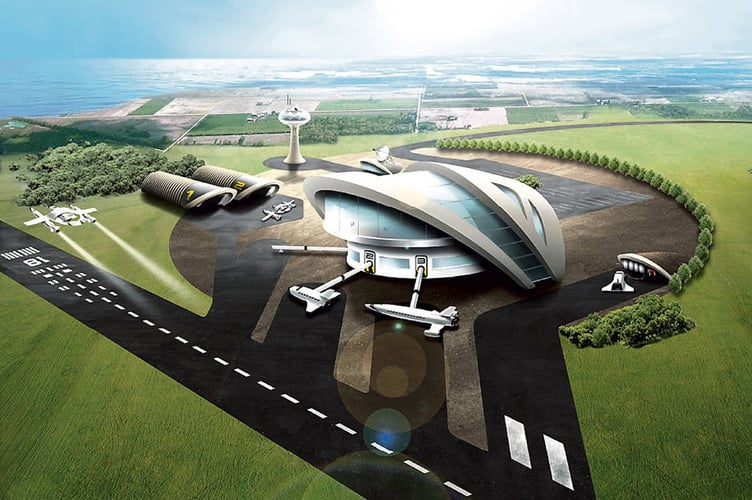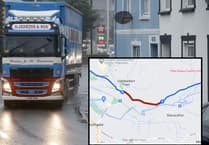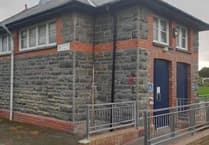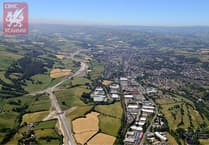The Welsh Government has ambitious plans to build a space industry that would be worth £2 billion to the national economy. This region is to play a key role in heading into orbit. CHRIS BETTELEY investigates
MID and North Wales are set to play a vital part in an ambitious Welsh Government commitment to capture a share of the UK space sector as it unveils a new plan that would bring an estimated £2 billion into the country’s economy
Developments in the region will focus on key sites in Llanbedr in Gwynedd and Aberporth in Ceredigion, as well expertise being drawn from academics at Aberystwyth University as Wales pushes to become a leading light in the field.
The sites in Llanbedr – where a Spaceflight Academy has been established with plans to begin flight training within 18 months – and Aberporth, are both set to receive funding to improve facilities.
Over the last five years, Welsh Government and Aerospace Wales have been working together to develop the space sector network to raise its profile and to develop and enhance its capability.
Work happening in Wales will include mapping, satellites, military use and exploration, with the Welsh Government expecting the sector to expand in the country over the next decade.
Sites across Wales will be used, with hubs and centres established and developed in south Wales alongside those in Ceredigion, Gwynedd and elsewhere.
Plans include launching Wales’ first satellite by the end of this year, with ambitious targets of being able to launch one a week by 2026.
The Wales Academic Space Partnership (WASP) was established to encourage co-operation between universities operating in the space sector and to strengthen the links with industry in the so-called “arc of innovation”.
Aerospace Wales formed a Space Group to encourage networking between existing sector specialists and an emerging group of disruptive technology start-ups. Welsh Government, Aerospace Wales and representatives from academia and industry have participated in space related events on a regular basis.
Since 2010, space has proven to be one of the UK’s fastest growing sectors, trebling in size and it now employs 42,000 people and generates an income of £14.8 billion each year, the report for the plan outlines.
The report: Wales – a sustainable space nation, says: “In the aerospace sector, Wales has around 10 per cent of the overall UK workforce and arguably punches above its weight.
“When it comes to the space sector, Wales has around one per cent of the overall UK workforce so there is a huge opportunity for growth in, what is itself, a significant growth sector.
“The UK space sector has previously set a target of achieving a 10 per cent share of the predicted £400 billion per annum global space market in 2030.
“A five per cent share for Wales would equate to £2 billion per year and we believe this is a realisable target that we should aim to achieve and work to exceed.
“The growth of the sector also has the potential to help us address some of the key issues facing Planet Earth and the challenges within Wales itself.
“We should use the technology and services facilitated by the space sector to help grow the economy in Wales and to help deliver enhanced essential services across the nation.
“As a result of the UKSA funded cluster development project, we have mapped out the current sector in Wales, identified the key opportunities afforded by the space sector and outlined the key recommendations and actions to be taken.
“We have established the Space Wales Leadership Group and the Space Wales network, including the Wales Academic Space Partnership.”
Wales ‘in a prime position’ - Vaughan Gething MS, Welsh Government Minister for Economy gives his view
“I’m delighted to present the Space Strategy for Wales, which reflects the wealth of capabilities and innovations we have in our nation.
“Wales has a track record of delivering high value manufacturing and innovation which puts our companies in a prime position to operate in this growing sector.
“The global space industry is rapidly transforming with space technology getting smaller and entry to space becoming more accessible and affordable.
“In all our day-to-day lives, we are becoming more reliant on the space sector and the data it provides, from weather forecasting, internet banking and Sat Nav in our vehicles.
“In Wales we not only have a strong foundation of companies and institutions operating in these downstream applications, but we also have a vibrant base of companies working in the upstream sector specialising in space hardware and systems.
“The UK Government has taken the positive decision to support the space industry in looking to build one of the most innovative and attractive space economies in the world, and grow the UK as a space nation.
“They aim to protect and defend UK interests in space, shape the space environment and use space to help solve challenges at home and overseas.
“Through cutting-edge research, they look to inspire the next generation and sustain the UK’s competitive edge in space science and technology.
“The Welsh Government fully backs this growth and we will work closely with the UK Space Agency to ensure that our national strategy for Wales aligns with the UK’s ambitions.”

Racing to space from Llanbedr
The Welsh Government has invested in developing Llanbedr – the home of Spaceport Snowdonia – to provide infrastructure and it is anticipated that there will be further development as a space and aerospace hub.
To fulfil the primary stated space-related objectives of the spaceport (Research, Development, Test & Evaluation and Sub-Orbital Flight Training), it will be necessary for the Welsh Government to continue to support the development of the site.
Over £20 million has been allocated for improvements to infrastructure in and around the site, to be completed by 2023. It is also being proposed as a spaceport and a spaceflight experience, training and aeromedical facility, Spaceflight Academy.
Spaceflight Academy plans to start the development of a spaceflight experience and training facility at Snowdonia’s Llanbedr airfield within 18 months.
Spaceflight Academy’s vision is “to be the world’s leading commercial Spaceflight and aeromedical training provider, motivated by our belief and experts’ advice that human factor aeromedical issues associated with commercial space travel and tourism for the public are no less important than the technological challenges of sending people into space.”
Their planned facilities will include a campus building designed to be an impressive gateway attraction for visitors to Spaceport Snowdonia.
Spaceflight Academy’s cutting-edge facility will include innovative and interactive ways to engage and inspire the public for a ‘whole Space experience’.
This fully immersive, compelling and exciting environment will support, encourage and promote the development of Space and commercial Space tourism. The facility will include a Desdemona NG, a unique, second generation, all-in-one motion simulator, spatial disorientation trainer and advanced laboratory capable of sustaining advanced G-loads up to 7g.
Blasting off in rockets tested in Aberporth
Aberporth range provides a controlled safe environment for the release of land, air and sea-launched missile firings as well as instrumentation verification, passive and active IR/RF jamming, and the ability to manage supersonic trials activity in its 7,500km² of sanitised airspace from surface to unlimited altitude.
The facility is owned by MoD, operated by QinetiQ and since 2003 has been open to civil use.
The range has a fully instrumented 3D area for Test and Evaluation and space for training activities.
It provides both live and virtual environments, real-time data, and deployable systems, all supported by a wealth of expertise.
Recent investment has created the Parc Aberporth Centre of Excellence, securing access for civil UAS to the existing Ministry of Defence (MOD) airspace danger areas over Cardigan Bay and the establishment of new segregated airspace, with unlimited height over water, dedicated to UAS testing and evaluation.
UAS use satellite communications and remote sensing instrumentation that can create opportunities for the space sector supply chain in Wales through shared products and services.
Aberporth will require further developments and improvements in support of the projected growth in the space domain.
Satellite data gathered in Aberystwyth
In 2017, Environment Systems, an Aberystwyth based data company, launched their Satellite Data Services.
A cloud-based platform to deliver near real time, always-on metrics to support agricultural supply chains, environmental monitoring natural capital assessments.
In 2020, Environment Systems Data Services processed and analysed over 400 million sq.km of satellite Earth observation imagery around the world.
Three years ago, Aberystwyth University, already a centre of excellence in research and teaching relating to Earth Observation, was awarded funding for the Living Wales project.
Living Wales is a unique and novel world-first concept that aims to capture the state and dynamics of the landscape of Wales in near real time, historically and into the future, through integration of earth observation data, supportive ground measurements and process models.
The project has recently been funded for a further two years and the University is working closely with National Resources Wales providing a long term system for understanding, monitoring and planning landscape change that is applicable at a national level and based on historical and near real time earth observations.




